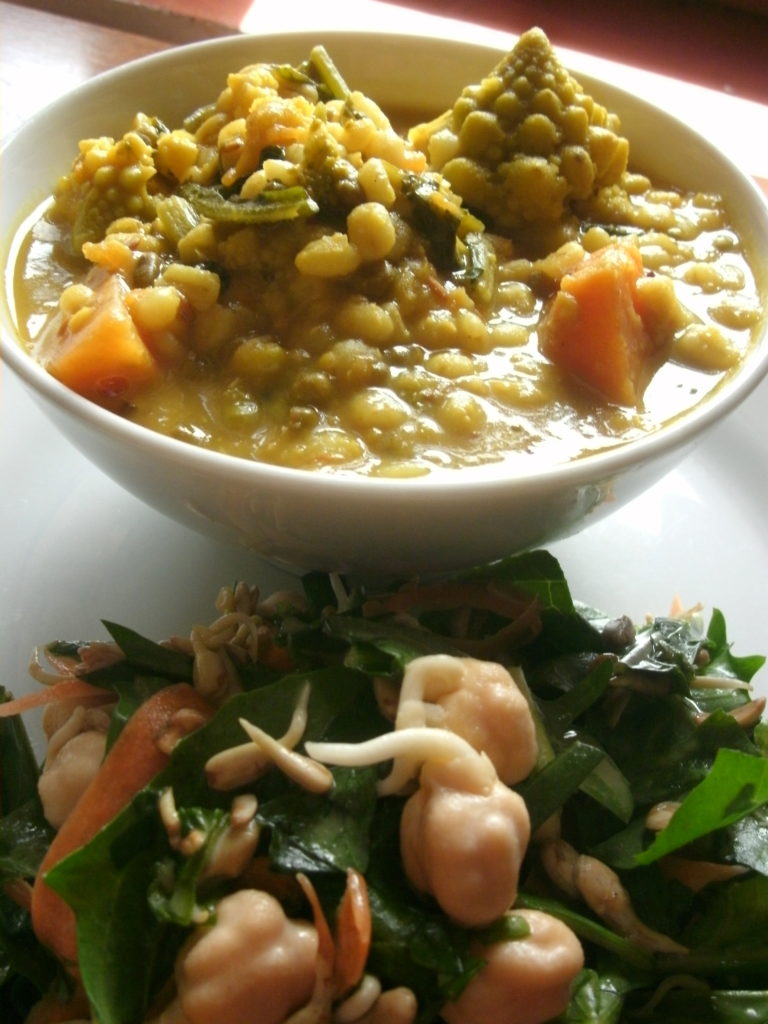
A whole new world can open when you start introducing the three gunas into your daily life as food directly impacts the mind.
I will show you the way on bringing Yoga into your Kitchen.
Tamas – Rajas -Sattva
The three gunas are one of the prime themes of ayurvedic thought. They help us understand our mental and spiritual nature and how it functions.
The gunas are qualities that help to define and describe everything in nature.
All three gunas are present in everything, all the time, and to different degrees.
A guna can be increased or decreased through the interaction and influence of external objects, lifestyle practices and thoughts.
TAMAS is a state of darkness, inertia, inactivity and materiality.
To reduce tamas avoid tamasic foods, over sleeping, over eating, inactivity, passivity and fearful situations.
Tamasic foods include heavy meats, and foods that are chemically treated, processed or refined.
RAJAS is a state of energy, action, change and movement.
The nature of rajas is of attraction, longing and attachment and rajas strongly binds us to the fruits of our work.
To reduce rajas avoid rajasic foods, over exercising, over work, loud music, excessive thinking and consuming excessive material goods.
Rajasic foods include fried foods, spicy foods, and stimulants.
SATTVA is a state of harmony, balance, joy and intelligence.
To increase sattva, we reduce both rajas and tamas, eat sattvic foods and enjoy activities and environments that produce joy and positive thoughts.
Quick Recap
- Sattva is the quality of balance, harmony, goodness, purity, universalizing, holistic, constructive, creative, building, positive, peaceful, virtuous.
- Rajas is the quality of passion, activity, neither good nor bad and sometimes either, self centeredness, egoistic, individualizing, driven, moving, dynamic.
- Tamas is the quality of imbalance, disorder, chaos, anxiety, impure, destructive, delusion, negative, dull or inactive, apathy, inertia or lethargy, violent, vicious, ignorant.
Is it Healthy?
Working with the gunas in the kitchen is a wonderful way to tune into the more subtle energies and vibrational qualities of foods. Rather than looking at a nutritional breakdown list to discern whether something is ‘healthy’ or not, here we look through a different lens, categorizing foods according to their character and effect upon the body and mind.
This approach is concerned with how food affects consciousness what we eat in essence becoming what we are.
When categorising foods as sattvic, rajasic or tamasic, we observe their effect on the human organism and ask:
- Do they create heat or dryness in the body?
- Do they create extreme cold or damp?
- Do they stimulate the system including glandular secretions and the psychic centres (chakras)?
- Do they have an extended nourishing effect?
- What are the after effects?
- Are the foods easily digestible or do they take time and a lot of energy to digest?
- Do the foods disturb the dosha’s: wind (vata), bile (pitta) and mucus (kapha)?
In terms of food, nutrition and cookery, sattva is the epitome of purity, freshness and vitality.
These are real ‘whole foods’ as close to their natural state as possible, grown in fertile soils and harvested at the correct time of the year. They are the ultimate high vibrational foods, abundant in prana and live enzymes.
Sattvic foods are generally the ones grown high up, further from the ground and closer to the sun.
What to eat…
Examples of sattvic foods include:
- fresh fruits
- vegetables such as artichokes, aubergines, lettuces, beetroots, mustard, green leafy veggies, asparagus, daikon, endive, fennel, maitake, chanterelle and shiitake mushrooms, parsnips, bok choy, peas, broccoli, green beans, brussels sprouts, broad beans, kale, radishes, cabbage, leeks, carrots, celery, spinach, cauliflower, chard, watercress, turnips, yams
- grains (pref sprouted) such as amaranth, barley, buckwheat, millet, quinoa, basmati, brown and wild rice
- oils olive, nut and seed oils, coconut, sesame
- nuts and seeds mainly almonds, brazil nuts, pumpkin seeds, sunflower seeds, walnuts
- herbs and spices asafoetida (hing), coriander, cumin, nutmeg, black pepper, fennel seed, parsley, basil, cardamom, fenugreek, turmeric, cinnamon, cloves, ginger
- milks and dairy seed and nut milks, hemp milk, ghee, organic unpasteurised yogurt
- sweeteners raw honey, molasses, stevia, fruit juices/syrups, maple syrup
The basis of sattva is ahimsa (non violence) so these foods have in no way seen harm or suffering to another being and so it is in essence a vegetarian diet.
In the ancient yogic tradition serious practitioners would consume only a sattvic diet. Most importantly they would only have been prepared by a chef/cook who embodied these qualities themselves.
Of course, not everyone wants the life of an aesthetic or to dedicate their life to samadhi and the path of ultimate enlightenment….
In everyday life in the modern world we need balance.
The three gunas in daily Life…
So how does the theory of the yogic diet apply to our life here and now, in the reality of the day to day? And how we can prioritise a higher percentage of sattvic foods in what we eat?
In an ideal world, sattvic foods are freshly picked and freshly cooked, the ultimate field to fork eating. However, in our fast paced, highly stimulated modern lifestyles and culture this is not so easy to access.
In fact we have to make a very clear conscious decision to make the quality of the food we eat a priority, going out of our way to source and seek fresh, vital food meaning local and seasonal as much as possible, grown without chemicals, pesticides and hormones, foods that are unprocessed and unrefined etc.
Even if we choose to buy organic from supermarkets and do our very best to eat an abundance of fruit, veg, whole grains, cereals, nuts and seeds we should be mindful that these products will often fall into the tamasic category inert, lifeless, rancid, lacking in nutrients and vitality.
We can be sure that these products have been on quite a journey, picked and packaged before they are properly ripe and mature, passed through many many hands and often denatured with who knows what added ingredients or processes along the way.
What’s the point?
This doesn’t need to be doom and gloom where we shrug our shoulders and sigh ‘what’s the point’. This is empowering information and we have a choice. Once we start seeking outside of the convenient we discover there is much more available to us than we think.
As a simple example; switch to shopping at a local farmer’s market or have a box delivery direct from farms, start a small allotment or grow what you can in window boxes or in the garden.
Quality over Quantity
Choose quality over quantity, eat and prepare food with a mindful conscious approach and make ethical and sustainable choices.
For those who do want to go deeper into the practice of yoga, meditation, self development and spirituality eating a high sattvic diet will be highly beneficial in assisting and supporting this journey.
This would include eliminating the following to create a perfect environment for clarity and stillness.
So even if not appropriate in daily life, it can be perfect for times on a yoga retreat. Or, when facing challenging moments or needing to make important decisions in daily life:
- All stimulating and irritating foods
- Foods that create cravings and desire
- Foods that create too much heat/cold
- Foods that stir up the mind and nervous system
Here are two of my favourite and more classic Sattvic recipes:
Hug in a Mug (Golden Milk)
Ingredients:
Plant based milk such as almond, hemp, rice, oat Cinnamon (stick or powder)
Ground ginger
Turmeric root or powder Pinch of black pepper
Crushed cardamom pods
Clove
Ghee or coconut oil
Method:
Add the milk to a saucepan with the spices, how much depends on how fragrant you like it to be, play with amounts to find what is right for you.
Gently simmer for approx 10-30 mins with a lid on the pan on a very low flame. How long depends again on how fragrant you want it.
WAIT!
Take 3 breaths before drinking, holding the mug in your hands and enjoy the wonderful aroma of this deeply nourishing drink.

Kichadi
There are endless ways to create a kichadi.
Play with combinations, basically it is the method that stays the same.
A kichadi can be thick or more soup like, depending on your preference.
It also loves to be stirred and looked after during the cooking process, which can be up to a few hours.
The longer you cook it, the more water it absorbs.
Beware, you can suddenly have a lot of kichadi on your hands!
Ingredients you can use:
Grains such as brown rice, quinoa, millet or pearl barley *
Pulses such as mung beans, aduki beans, lentils or chickpeas (all soaked, precooking a little chickpeas or aduki beans can help)
Veggies roughly chopped such as cauliflower, courgette, squash, carrots, sweet potato, beetroot, broccoli, cabbage, green leafy veg, leeks
Ginger finely chopped
Bayleaf just 1 or two is fine
Spices if you want to use (cumin, coriander, garam masala, black mustard seeds, turmeric)
Small piece of Kombu seaweed (not traditional but helps during the cooking of the pulses to aid digestion) more traditional would be a pinch of ‘hing’ or asafoetida.
* Use a rough guide of approx 1 cup grain to 2 cups pulse to 8 cups of water.
Add seasonings at the end after tasting to check.
Method:
Wash your grains and pulses well.
Soak them overnight in plenty of water and a squeeze of lemon juice. Rinse and drain when ready to use.
Sauté in coconut oil or ghee seeds such as cumin, coriander, mustard.
Add the ginger and sauté.
Add turmeric, sauté.
Add the grains and pulses, sauté. (Add a splash of water at any time if sticking.)
Add the hardest veg and sauté.
Add water to cover a good few centimeters above the ingredients.
This will absorb a lot of water.
Bring to the boil, stir and turn to simmer.
Add the kombu or asafoetida.
Keep checking regularly and stir, if you need to add more water do so.
Once the grains and beans are cooked, add the next hardest veg (things like squash, broccoli stalks, courgettes etc).
Cook until they are soft.
At the end add the green leafy veg and turn off the heat and cover.
Let the greens wilt into the dish.
ENJOY!
By bringing in yoga into your kitchen and working with the three gunas, you will have a great road map for navigating your way through the yogic diet.
Hope you have enjoyed reading this, feel inspired to make the recipes and I appreciate any and all comments!
By Hayley North
Hayley has many years of experience catering for yoga retreats all over the world and her food is known for being inspiring, creative, packed with vitality, nourishing and educational.
To find out more about Hayley, her food, courses and to access her eBook go to www.hayleynorth.co.uk







What meat types are good for the balance of gunas? I need to eat meat of some type at least 3 to 4 times a week.
Thank you for your comment! Best thing to do is to contact Hayley North, she can ask the right questions and no doubt help you further: http://hayleynorth.co.uk
Namaste!